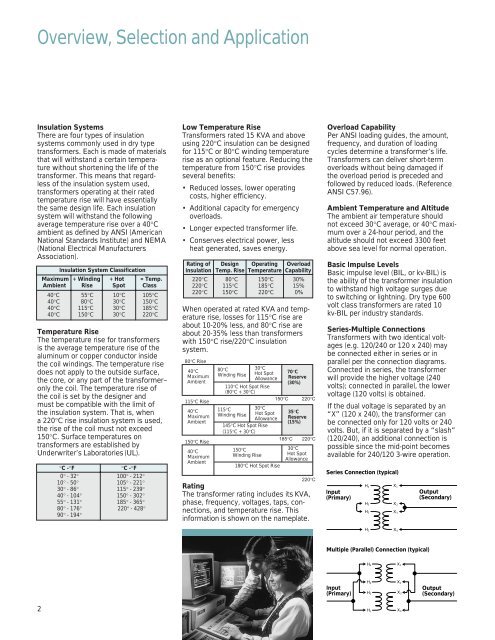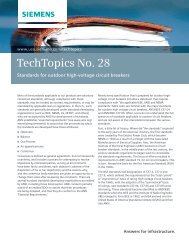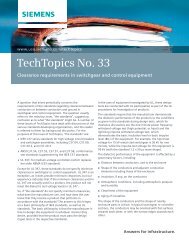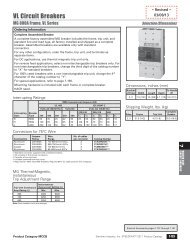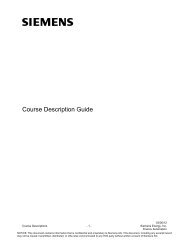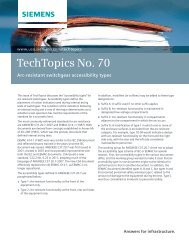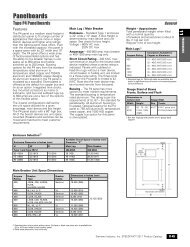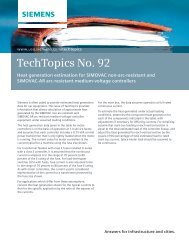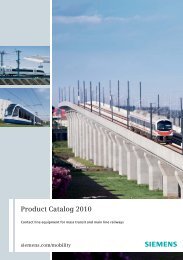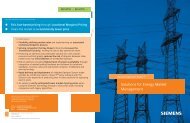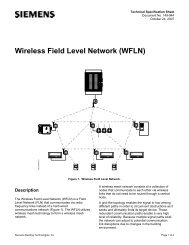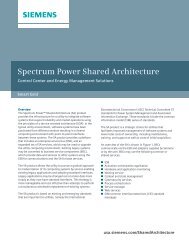Cover/Back.preflight (Page 2) - Siemens
Cover/Back.preflight (Page 2) - Siemens
Cover/Back.preflight (Page 2) - Siemens
You also want an ePaper? Increase the reach of your titles
YUMPU automatically turns print PDFs into web optimized ePapers that Google loves.
Overview, Selection and Application<br />
Insulation Systems<br />
There are four types of insulation<br />
systems commonly used in dry type<br />
transformers. Each is made of materials<br />
that will withstand a certain temperature<br />
without shortening the life of the<br />
transformer. This means that regardless<br />
of the insulation system used,<br />
transformers operating at their rated<br />
temperature rise will have essentially<br />
the same design life. Each insulation<br />
system will withstand the following<br />
average temperature rise over a 40°C<br />
ambient as defined by ANSI (American<br />
National Standards Institute) and NEMA<br />
(National Electrical Manufacturers<br />
Association).<br />
Insulation System Classification<br />
Maximum + Winding + Hot = Temp.<br />
Ambient Rise Spot Class<br />
40°C 55°C 10°C 105°C<br />
40°C 80°C 30°C 150°C<br />
40°C 115°C 30°C 185°C<br />
40°C 150°C 30°C 220°C<br />
Temperature Rise<br />
The temperature rise for transformers<br />
is the average temperature rise of the<br />
aluminum or copper conductor inside<br />
the coil windings. The temperature rise<br />
does not apply to the outside surface,<br />
the core, or any part of the transformer–<br />
only the coil. The temperature rise of<br />
the coil is set by the designer and<br />
must be compatible with the limit of<br />
the insulation system. That is, when<br />
a 220°C rise insulation system is used,<br />
the rise of the coil must not exceed<br />
150°C. Surface temperatures on<br />
transformers are established by<br />
Underwriter’s Laboratories (UL).<br />
°C -°F °C -°F<br />
0° - 32° 100° - 212°<br />
10° - 50° 105° - 221°<br />
30° - 86° 115° - 239°<br />
40° - 104° 150° - 302°<br />
55° - 131° 185° - 365°<br />
80° - 176° 220° - 428°<br />
90° - 194°<br />
Low Temperature Rise<br />
Transformers rated 15 KVA and above<br />
using 220°C insulation can be designed<br />
for 115°C or 80°C winding temperature<br />
rise as an optional feature. Reducing the<br />
temperature from 150°C rise provides<br />
several benefits:<br />
• Reduced losses, lower operating<br />
costs, higher efficiency.<br />
• Additional capacity for emergency<br />
overloads.<br />
• Longer expected transformer life.<br />
• Conserves electrical power, less<br />
heat generated, saves energy.<br />
Rating of Design Operating Overload<br />
Insulation Temp. Rise Temperature Capability<br />
220°C 80°C 150°C 30%<br />
220°C 115°C 185°C 15%<br />
220°C 150°C 220°C 0%<br />
When operated at rated KVA and temperature<br />
rise, losses for 115°C rise are<br />
about 10-20% less, and 80°C rise are<br />
about 20-35% less than transformers<br />
with 150°C rise/220°C insulation<br />
system.<br />
80°C Rise<br />
40°C 80°C 30°C<br />
Maximum Winding Rise Hot Spot 70°C<br />
Allowance Reserve<br />
Ambient<br />
(30%)<br />
110°C Hot Spot Rise<br />
(80°C + 30°C)<br />
150°C 220°C<br />
115°C Rise<br />
40°C 115°C 30°C<br />
Maximum Winding Rise Hot Spot 35°C<br />
Allowance Reserve<br />
Ambient<br />
(15%)<br />
145°C Hot Spot Rise<br />
(115°C + 30°C)<br />
150°C Rise<br />
185°C 220°C<br />
40°C 150°C 30°C<br />
Maximum Winding Rise Hot Spot<br />
Allowance<br />
Ambient<br />
180°C Hot Spot Rise<br />
220°C<br />
Rating<br />
The transformer rating includes its KVA,<br />
phase, frequency, voltages, taps, connections,<br />
and temperature rise. This<br />
information is shown on the nameplate.<br />
Overload Capability<br />
Per ANSI loading guides, the amount,<br />
frequency, and duration of loading<br />
cycles determine a transformer’s life.<br />
Transformers can deliver short-term<br />
overloads without being damaged if<br />
the overload period is preceded and<br />
followed by reduced loads. (Reference<br />
ANSI C57.96).<br />
Ambient Temperature and Altitude<br />
The ambient air temperature should<br />
not exceed 30°C average, or 40°C maximum<br />
over a 24-hour period, and the<br />
altitude should not exceed 3300 feet<br />
above sea level for normal operation.<br />
Basic Impulse Levels<br />
Basic impulse level (BIL, or kv-BIL) is<br />
the ability of the transformer insulation<br />
to withstand high voltage surges due<br />
to switching or lightning. Dry type 600<br />
volt class transformers are rated 10<br />
kv-BIL per industry standards.<br />
Series-Multiple Connections<br />
Transformers with two identical voltages<br />
(e.g. 120/240 or 120 x 240) may<br />
be connected either in series or in<br />
parallel per the connection diagrams.<br />
Connected in series, the transformer<br />
will provide the higher voltage (240<br />
volts); connected in parallel, the lower<br />
voltage (120 volts) is obtained.<br />
If the dual voltage is separated by an<br />
“X” (120 x 240), the transformer can<br />
be connected only for 120 volts or 240<br />
volts. But, if it is separated by a “slash”<br />
(120/240), an additional connection is<br />
possible since the mid-point becomes<br />
available for 240/120 3-wire operation.<br />
Series Connection (typical)<br />
Input<br />
(Primary)<br />
H4<br />
H3<br />
H2<br />
X 1<br />
X2<br />
X3<br />
Output<br />
(Secondary)<br />
H1<br />
X4<br />
Multiple (Parallel) Connection (typical)<br />
H4<br />
X 1<br />
Input<br />
(Primary)<br />
H3<br />
H2<br />
X2<br />
X3<br />
Output<br />
(Secondary)<br />
2<br />
H1<br />
X4


